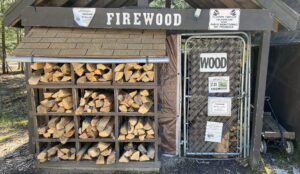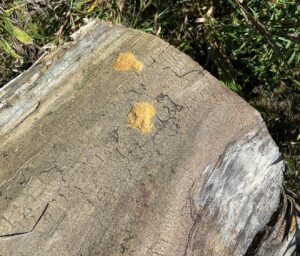
A stand at Potawatomi State Park offers local firewood for sale to campers. / Photo Credit: Wisconsin DNR
By Wisconsin DNR
With the onset of autumn, many Wisconsinites have been making plans to stock up on firewood for the winter.
With that in mind, the Wisconsin Department of Natural Resources (DNR) is reminding residents and visitors about the year-round importance of obtaining firewood from local sources — whether it’s to heat your home in the winter or build a campfire in the summer.
The message is important enough that October has been designated National Firewood Month, and the DNR offers a webpage to explain firewood regulations, best practices and the reasons behind those guidelines.

A pair of spongy moth egg masses attached to a piece of firewood. Moving this firewood to another site could put trees at that site at risk in the spring. / Photo Credit: Wisconsin DNR
Transporting firewood opens the possibility for invasive insects and diseases to hitch a ride and infest previously healthy trees in your yard, your community and your county. Insects such as emerald ash borer and spongy moth [exit DNR] are common firewood hitchhikers, as are the tiny spores of the tree-killing fungal disease oak wilt.
Insects that pose problems for trees in other states and appear to be advancing toward Wisconsin — though not found here yet — are the insects Asian longhorned beetle and hemlock woolly adelgid, along with beech leaf disease.
In Wisconsin, state parks and other state-managed lands prohibit visitors from bringing in firewood from further than 10 miles from the property. Also, state properties that offer campgrounds sell local firewood from an on-site kiosk.
Treated, pest-free wood from state-certified vendors [exit DNR] is exempt from the distance regulations (receipts should be kept). Wood that is simply aged or seasoned is not considered safe to move; it must be kiln-dried to destroy all the pests that might reside in the wood.
Even if firewood appears freshly cut, clean and healthy, it could still harbor tiny insect eggs or microscopic fungal spores, which could start a new and deadly infestation.
Past invaders have devastated native species of trees such as the American chestnut and elm. Those species had been common in American forests and city locations before the spread of the invasive and deadly pests.
The Nature Conservancy has created a “Don’t Move Firewood” website with information on the importance of keeping firewood local. That group has also helped with the creation of a “Firewood Scout” website with maps showing places to buy local or certified firewood.
“When people learn why they shouldn’t transport firewood long distances, the vast majority are willing to buy it where they burn it,” said Leigh Greenwood, Don’t Move Firewood campaign manager.
“People have the power to save their trees. They can help stop the spread of destructive pests by not moving firewood and communicating this message to others.”
